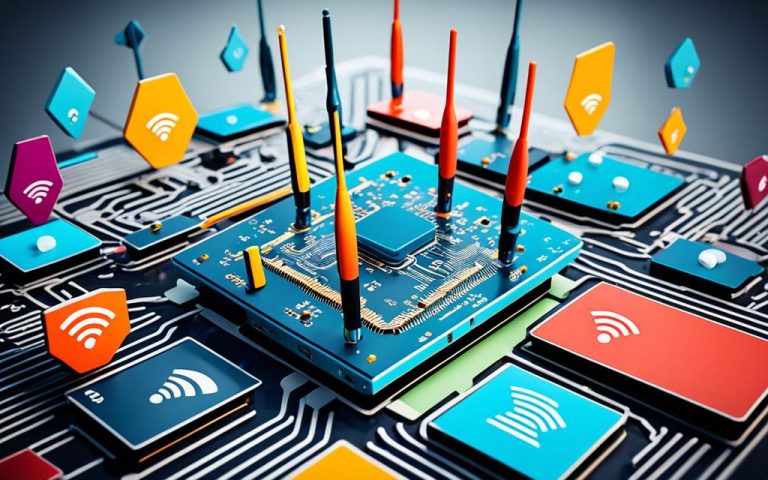The concept of smart cities is revolutionizing urbanization, as governments across the globe strive to address the complexities of modern living. Smart cities utilize digital technologies, including local area wireless networks, to enhance the well-being of residents, optimize service efficiency, and propel sustainable development. In this article, we will explore the crucial role of Wi-Fi and smart cities in shaping the future of urban connectivity, efficiency, and innovation.
Smart cities require robust local area wireless networks to support a diverse range of applications with varying performance requirements. These networks serve as the backbone for seamless connectivity and communication, enabling innovative solutions for transportation, energy management, public safety, and more. Whether it’s real-time traffic monitoring, remote control of city infrastructure, or data collection from sensors, local area wireless networks are the technological lifeline driving the efficiency and effectiveness of smart city services.
In the following sections, we will delve deeper into the importance of local area wireless networks in smart cities, exploring their performance requirements, capacity, reliability, and security. We will also discuss the networking challenges faced by smart cities and the solutions that are transforming fragmented networks into cohesive systems. Additionally, we will look at real-life examples of cities around the world that have successfully implemented private cellular networks, leveraging the power of 5G technology to support their smart city initiatives.
Join us on this journey to discover the boundless possibilities that local area wireless networks offer in building smarter cities for a brighter future of urban connectivity, efficiency, innovation, and modern living.
The Importance of Local Area Wireless Networks in Smart Cities
Local area wireless networks are instrumental in the success of smart cities as they enable seamless connectivity and communication to support various applications. These networks play a crucial role in ensuring the smooth functioning of smart city initiatives. From powering Wi-Fi hotspots to enabling IoT devices, local area wireless networks are at the heart of urban connectivity.
In order to meet the diverse performance requirements of smart cities, local area wireless networks must possess certain key attributes. These include:
- Capacity: Smart cities generate enormous amounts of data from a wide range of applications. Local area wireless networks need to have sufficient capacity to handle this data load efficiently.
- Reliability: The reliability of local area wireless networks is paramount in smart cities, as uninterrupted connectivity is essential for critical services and applications.
- Security: With the increasing number of connected devices and sensitive data being transmitted, security becomes a top priority. Local area wireless networks must have robust security measures in place to protect against potential threats.
- Performance requirements: Smart city applications have diverse performance requirements, including low latency, high throughput, and mobility support. Local area wireless networks must be capable of meeting these requirements to ensure smooth operation.
Private networks offer distinct advantages over public networks when it comes to local area wireless networks in smart cities. Private networks provide greater reliability, improved security, and better control and flexibility. They also offer higher bandwidth options and allow for customization of the network infrastructure to support high-performance applications.
Overall, the importance of local area wireless networks in smart cities cannot be underestimated. These networks form the backbone of urban connectivity, enabling the efficient functioning of various smart city applications and services.
Example Use Case: Wireless Video Surveillance in Smart Cities
One illustrative use case for local area wireless networks in smart cities is wireless video surveillance. Surveillance cameras play a crucial role in enhancing security and monitoring activities in public spaces. By utilizing local area wireless networks, these cameras can transmit real-time video footage to a central monitoring station, enabling authorities to promptly respond to any incidents or threats.
With the capacity to handle large amounts of data and the reliability to ensure continuous video streaming, local area wireless networks provide the necessary infrastructure for effective video surveillance systems in smart cities.
| Benefits of Local Area Wireless Networks in Smart Cities | Challenges |
|---|---|
| Enables seamless connectivity for IoT devices. | Increase in network traffic due to the proliferation of connected devices. |
| Supports high-performance applications such as remote drone control. | Ensuring network security and protecting sensitive data. |
| Facilitates efficient data transmission for real-time monitoring and response. | Meeting the diverse performance requirements of different smart city applications. |
| Improves the overall efficiency and effectiveness of smart city services. | Scalability to accommodate future growth and advancements in technology. |
Networking Challenges and Solutions in Smart Cities
Smart city networks initially faced numerous challenges due to their focus on individual use cases and domains, resulting in fragmented networks that lacked cohesive solutions. However, advancements in technology have paved the way for innovative approaches to overcome these challenges and create more efficient and interconnected smart city networks.
Fragmented Networks: A Networking Challenge
Fragmented networks in smart cities present several challenges, including limited interoperability between different systems and difficulty in managing and coordinating various applications. This fragmentation hinders the seamless exchange of data and prevents the realization of the true potential of smart cities.
One solution to address this challenge is the utilization of cohesive solutions that integrate various networks and platforms, enabling efficient data exchange and collaboration across different domains. By implementing standardized protocols and frameworks, smart cities can overcome the barriers posed by fragmented networks and achieve a more connected and collaborative environment.
Optimizing Traffic Management with Video Analytics
Traffic congestion is a common issue faced by urban areas, impacting both the efficiency of transportation systems and quality of life for residents. To address this challenge, smart cities are leveraging video analytics technologies to visualize traffic flows and identify congestion points in real-time.
By deploying monitoring devices equipped with video analytics capabilities, smart cities can collect and analyze data on traffic patterns, enabling them to make data-driven decisions to optimize traffic management and improve overall transportation efficiency. With these insights, traffic management authorities can identify bottlenecks, implement intelligent traffic signal control systems, and efficiently allocate resources to alleviate congestion and improve traffic flow.
Remote Monitoring and Control of Smart City Utilities
Smart city utilities, such as water management systems, energy grids, and waste management facilities, require constant monitoring and maintenance to ensure efficient operation. Traditional approaches to monitoring and control can be time-consuming and inefficient, leading to delays in identifying faults and potential failures.

To address this challenge, smart cities are leveraging private networks to remotely monitor and control utility operations. Data sensors deployed throughout the infrastructure collect real-time data on system performance, allowing operators to detect faults, anticipate failures, and quickly respond to emergencies. This proactive approach improves the reliability and resilience of smart city utilities, minimizing downtime and enhancing overall operational efficiency.
Bridging the Digital Divide with Private Networks
Access to reliable and affordable internet connectivity is essential for economic development and social inclusion. However, many underserved areas still lack adequate connectivity, leading to a digital divide that hinders equal access to opportunities and services.
Municipalities are addressing this challenge by utilizing private networks to extend connectivity to underserved areas. These networks provide high-speed internet access, enabling residents to access e-learning initiatives, online services, and job opportunities. By bridging the digital divide, smart cities can promote inclusivity and ensure that all citizens can participate in the digital era.
In conclusion, smart city networks face various challenges, including fragmented systems and limited interoperability. However, with the advancements in video analytics, monitoring devices, and private networks, these challenges can be addressed effectively. By implementing cohesive solutions, visualizing traffic flows, remotely monitoring utilities, and extending connectivity to underserved areas, smart cities can overcome these challenges and create more efficient, interconnected, and inclusive urban environments.
Examples of Private Cellular Networks in Smart Cities
Various cities around the world have implemented private cellular networks to support their smart city initiatives. These networks leverage advanced technologies such as 5G and wireless connectivity to enable innovative city applications across various domains. Let’s take a closer look at some notable examples:
Tampere, Finland
Tampere, a city in Finland, has implemented a unique wireless connectivity system that utilizes LED lighting fixtures and wireless controls. This innovative approach improves energy efficiency and creates better lighting conditions throughout the city. By leveraging private cellular networks, Tampere showcases how smart cities can optimize energy management while providing enhanced wireless connectivity.
Las Vegas, United States
Las Vegas stands out as a leading smart city with the largest private 5G network deployed in the United States. This extensive network supports applications like traffic management, public safety, and environmental monitoring. Las Vegas demonstrates how private cellular networks enable efficient traffic management systems, enhance public safety measures, and enable real-time environmental monitoring to ensure a sustainable and secure urban environment.
Ban Chang, Thailand
Ban Chang, a Thai city, is in the process of implementing a private 5G network for a new smart city development. This network will unlock numerous possibilities for innovative city applications, including Internet of Things (IoT) sensors, robotics, and autonomous vehicles. Ban Chang’s investment in private cellular networks showcases its commitment to creating a technologically advanced and connected urban environment for its residents and businesses.
Bahrain
Bahrain is embracing the power of private LTE networks to monitor critical infrastructure across the city. By deploying a private LTE network, Bahrain ensures seamless connectivity for real-time data exchange and efficient management of its essential facilities. This demonstrates how private cellular networks contribute to ensuring public safety and optimal operation of critical infrastructure in a smart city setting.
These examples highlight the versatility and impact of private cellular networks in facilitating wireless connectivity and driving innovation in smart cities. With the help of these networks, cities can integrate advanced technologies, improve services, and enhance the quality of life for their residents.
| City | Country | Private Network Deployment | Applications |
|---|---|---|---|
| Tampere | Finland | Wireless connectivity system using LED lighting fixtures and wireless controls | Improved energy efficiency, enhanced wireless connectivity |
| Las Vegas | United States | Largest private 5G network in the US | Traffic management, public safety, environmental monitoring |
| Ban Chang | Thailand | Private 5G network for a new smart city development | IoT sensors, robotics, autonomous vehicles |
| Bahrain | Bahrain | Private LTE network for monitoring critical infrastructure | Efficient infrastructure management, public safety |
Conclusion
The rapid growth of smart cities is reshaping urban landscapes and revolutionizing the way we live. With an expanding array of applications and use cases, the demand for efficient and reliable connectivity has never been greater. Local area wireless networks, including Wi-Fi, are at the forefront of this transformation, playing a crucial role in meeting the intricate demands of smart cities.
These local area wireless networks offer numerous benefits that are essential for the success of smart cities. They provide enhanced reliability, ensuring seamless connectivity and minimizing disruptions in critical services. Security is also a top priority, as private networks offer better control and protection against cyber threats, safeguarding both data and infrastructure.
Furthermore, local area wireless networks enable greater customization, allowing cities to adapt and scale their connectivity infrastructure according to specific needs. This flexibility empowers cities to innovate and integrate emerging technologies, paving the way for the future of urban connectivity.
As local area wireless networks continue to evolve, smart cities will experience increased efficiency and innovation across various sectors. From advanced traffic management systems and public safety enhancements to energy management and sustainable initiatives, the benefits are far-reaching. Ultimately, embracing the potential of local area wireless networks is key to creating smarter, more connected cities that improve the quality of life for residents and promote sustainable urban development.
FAQ
What are smart cities?
Smart cities are urban areas that utilize digital technologies to enhance the well-being of residents, optimize service efficiency, and promote sustainable development.
Why are local area wireless networks important in smart cities?
Local area wireless networks play a crucial role in smart cities as they facilitate connectivity and communication for various applications, meeting diverse performance requirements and supporting a wide range of use cases.
What advantages do private networks offer for smart cities?
Private networks offer advantages like greater reliability, security, control, and customization, making them ideal for meeting the needs of smart cities.
What challenges do smart city networks face?
Smart city networks initially focused on individual use cases and domains, resulting in fragmented networks. However, technologies like video analytics help visualize traffic flows across cities, aiding in congestion management and optimization.
How do private networks contribute to smart city utilities?
Private networks allow smart city utilities to remotely monitor their operations, detect faults, and enable real-time communication among first responders, ultimately enhancing efficiency and mitigating risks.
Can private networks help bridge the digital divide in smart cities?
Yes, municipalities are utilizing private networks to provide connectivity to underserved areas and support e-learning initiatives in schools, ensuring equal access to technology.
Are there examples of private cellular networks in smart cities?
Yes, various cities around the world have implemented private cellular networks. For instance, Tampere in Finland uses a wireless connectivity system with LED lighting fixtures. Las Vegas has deployed the largest private 5G network in the United States, and Ban Chang in Thailand is implementing a private 5G network for a new smart city development.
What benefits do local area wireless networks offer for smart cities?
Local area wireless networks provide enhanced reliability, security, and control, making them ideal for supporting diverse applications and future innovations in smart cities.
How will urban connectivity continue to evolve in smart cities?
With the continued development of local area wireless networks and the adoption of smart city solutions, urban connectivity will foster efficiency, innovation, and improve the overall quality of modern living.



















